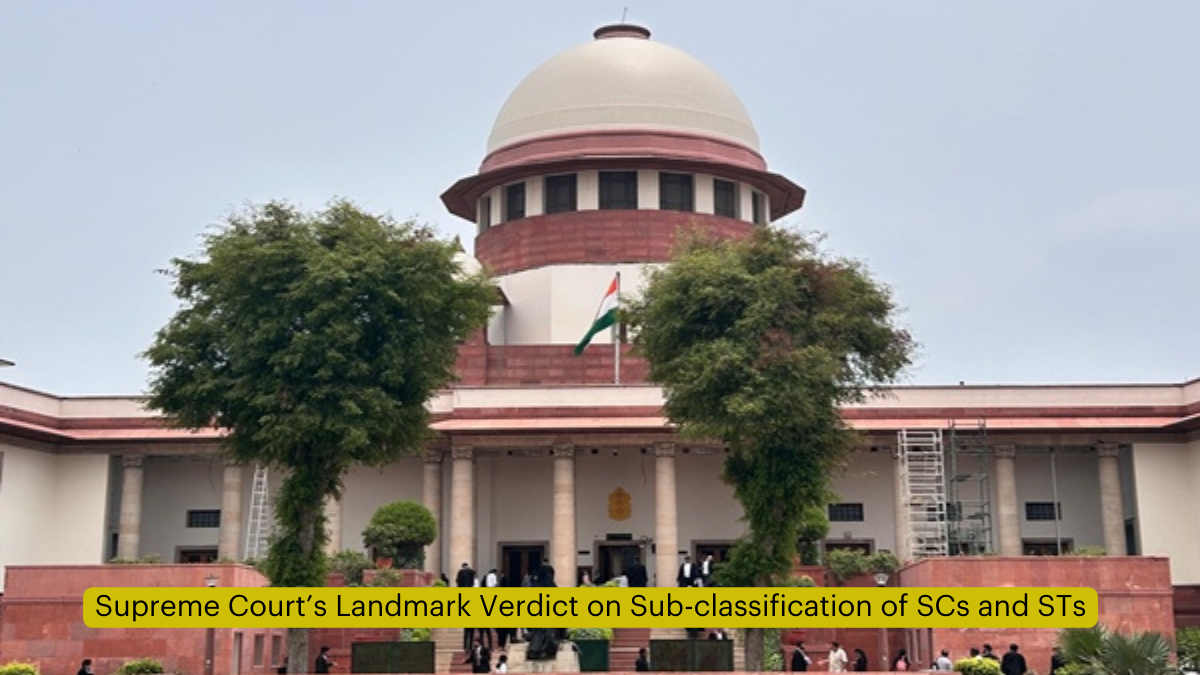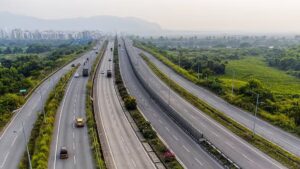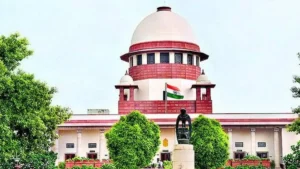On August 1, 2024, a seven-judge Bench of the Supreme Court of India delivered a landmark judgement that reframed the operation of the Scheduled Castes (SC) and Scheduled Tribes (ST) quota for the first time since reservations were introduced in the Constitution in 1950. This historic verdict saw six separate opinions, with five in favor of sub-classification and a lone dissent by Justice Bela Trivedi.
Historical Context and Constitutional Provisions
Article 341 of the Constitution
Article 341 allows the President, through a public notification, to list “castes, races or tribes” that suffered historical injustices, particularly untouchability, as SCs. These groups are collectively accorded 15% reservation in education and public employment.
Judicial Challenges and Attempts at Sub-classification
Over the years, some groups within the SC list have been underrepresented compared to others. Various states have made attempts to extend more protection to these groups, but these efforts often encountered judicial scrutiny.
The 1975 Punjab Notification
In 1975, Punjab issued a notification giving first preference in SC reservations to the Balmiki and Mazhabi Sikh communities, two of the most backward communities in the state. This notification was challenged in 2004 after the Supreme Court struck down a similar law in Andhra Pradesh in the case of E V Chinnaiah.
E V Chinnaiah Decision
The court held that any attempts to differentiate within the SC list would essentially amount to altering it, for which the Constitution does not empower states. Article 341 only empowers the President to issue such notifications and Parliament to make additions or deletions to the list. The court also noted that sub-classifying SCs violates the right to equality under Article 14.
Subsequent Developments in Punjab
Despite the court’s ruling, in 2006, the Punjab government passed the Punjab Scheduled Caste and Backward Classes (Reservation in Services) Act, reintroducing the first preference in reservations for the Balmiki and Mazhabi Sikh communities. This Act was challenged by Davinder Singh, a member of a non-Balmiki, non-Mazhabi Sikh SC community, and the Punjab & Haryana High Court struck down the Act in 2010, leading to an appeal at the Supreme Court.
Reconsideration of E V Chinnaiah
In 2020, the Justice Arun Mishra-headed Constitution Bench in Davinder Singh v State of Punjab held that the E V Chinnaiah decision required reconsideration. The ruling noted that the court and the state “cannot be a silent spectator and shut its eyes to stark realities”. Crucially, it disagreed with the premise that SCs are a homogeneous group, acknowledging the existence of “unequals within the list of Scheduled Castes, Scheduled Tribes, and socially and educationally backward classes”.
The Seven-Judge Bench
In February 2024, a seven-judge Bench was convened to hear the issue. Here are the key issues before the Bench:
Key Issues Before the Bench
Issue 1: Are All Castes in the SC List to Be Treated Similarly?
Article 341(1) gives the President the power to specify the castes, races, or tribes in a state that shall be deemed to be Scheduled Castes. The court in E V Chinnaiah held that SCs must be treated identically, without considering their relative backwardness.
Supreme Court’s Current Verdict
Chief Justice of India (CJI) Chandrachud rejected the premise of treating all SCs identically, stating that the inclusion in the Presidential list does not automatically lead to a uniform and homogeneous class. The CJI termed the Presidential list of SCs a “legal fiction”, created to provide benefits to communities in the list. He emphasized that this legal fiction cannot be stretched to claim that there are no internal differences among SCs.
Issue 2: Can States ‘Tinker’ with or Sub-classify the Presidential List?
Articles 15(4) and 16(4) of the Constitution give states the power to make special provisions for the advancement of SCs and provide reservations in education and public employment.
Supreme Court’s Current Verdict
The majority opinion held that states, in exercising their powers under Articles 15 and 16, can identify different degrees of social backwardness and provide special provisions to achieve the specific degree of harm identified. Justice Gavai noted that equality of opportunity must account for the varying social positions of different communities. When the same opportunities are provided to SC communities that are on different footings, it can only aggravate inequality.
Issue 3: Yardstick for Sub-classification
The majority opinion established stringent guidelines for states on how to work out sub-quotas. States must demonstrate a need for wider protections, bring empirical evidence, and have a reasonable rationale for classifying sub-groups. This reasoning can be tested in court.
Supreme Court’s Current Verdict
CJI Chandrachud emphasized that any form of representation in public services must be “effective representation”, not merely “numerical representation”. Even if an SC community is adequately represented in numbers, they may be barred from achieving effective representation by being promoted to higher posts. The state must prove that the sub-group carved out from the larger SC group is more disadvantaged and inadequately represented, based on quantifiable data.
Issue 4: Application of ‘Creamy Layer’ Principle to Scheduled Castes
The concept of the ‘creamy layer’ places an income ceiling on reservation eligibility, ensuring that the beneficiaries are those in a community that need quotas the most.
Supreme Court’s Current Verdict
Only Justice Gavai supported the introduction of the ‘creamy layer’ exception for SCs and STs. Four of the seven judges agreed with Justice Gavai’s opinion on the matter.
State-wise Prominent Tribal and Dalit Communities
Maharashtra
- Scheduled Castes: Mahar and Matang are the most prominent SC communities. The Mahar community, socio-politically proactive, has a high literacy rate. Many embraced Buddhism in 1956 following Dr. B.R. Ambedkar.
- Scheduled Tribes: Gond and Bhil are the two largest tribes. Gond live in Vidarbha, while Bhil are concentrated in North Maharashtra districts.
Rajasthan
- Scheduled Castes: Meghwal is the largest SC community, mainly in border districts. Bairwa and Jatav are dominant in eastern Rajasthan.
- Scheduled Tribes: Meena are the most dominant tribe, influencing electoral outcomes in numerous Assembly seats. Bhil are dominant in Banswara and Dungarpur districts.
Odisha
- Scheduled Tribes: Tribals form 22.85% of the state’s population. Khond and Santal are the largest tribes.
- Scheduled Castes: Pan are the dominant SC community, followed by Dom and other communities like Dhoba and Ganda.
Chhattisgarh
- Scheduled Tribes: STs make up over 30% of the population. Gond are the most dominant tribe, followed by Kawar/Kanwar and Oraon.
- Scheduled Castes: SCs constitute 12.7% of the population, with the largest group known by multiple names like Bairwa and Raidas.
Madhya Pradesh
- Scheduled Castes: SCs are about 15.6% of the population. The largest Dalit group are traditionally leather workers. Balai constitute about 12% of the SC population.
- Scheduled Tribes: STs make up 21% of the population. Bhil are the largest community, followed by Gond.
West Bengal
- Scheduled Castes: Rajbanshi are the largest SC group, influencing electoral outcomes in North Bengal. Matua are the second largest, followed by Bagdi.
- Scheduled Tribes: Bhil are dominant in the districts of Dang, Panchmahal, Bharuch, Banaskantha, and Sabarkantha.
Gujarat
- Scheduled Castes: Vankar, who are traditionally weavers, make up around 35-40% of the SC population. Rohit are the next most dominant SC community.
- Scheduled Tribes: Bhil constitute almost 43% of the tribal population, with Halpati making up over 6% of the state’s tribals.
Assam
- Scheduled Tribes: Tribals form 12.4% of the total population. Bodo are the largest and politically most powerful tribe. Karbi are the largest hill tribe.
Tripura
- Scheduled Tribes: 19 recognized tribal communities make up over 30% of the population. The ancient Tripuri clan includes the Debbarma community.
- Scheduled Castes: SCs include the Das, Badyakar, Shabdakar, and Sarkar communities.
Uttarakhand
- Population Composition: Thakur and Brahmin constitute around 55% of the population. OBCs are about 18%, and SCs and STs together make up about 22%.
- Scheduled Castes and Tribes: Harijan and Balmiki are the largest SC groups. Jaunsari and Tharu are the two largest ST groups.
Credit: Indian Express




 Centre Unveils ₹17 Lakh Crore PPP Projec...
Centre Unveils ₹17 Lakh Crore PPP Projec...
 Haryana to Launch India's First Hydrogen...
Haryana to Launch India's First Hydrogen...
 Supreme Court Signs MoU for Law Clerks E...
Supreme Court Signs MoU for Law Clerks E...







